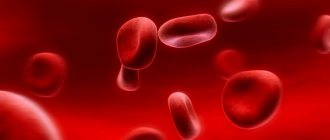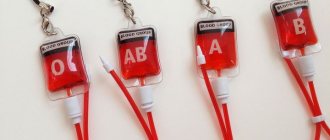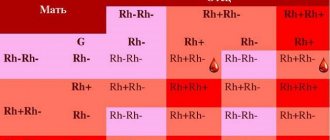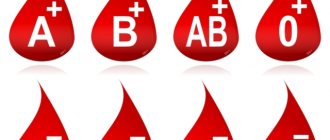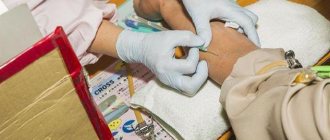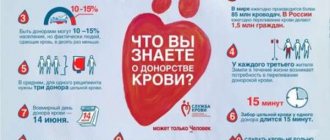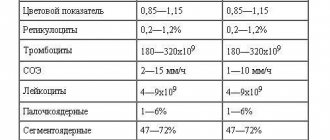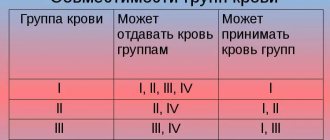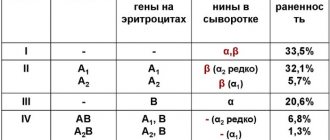Types of blood
What blood groups does a person have, how many groups are there, and the very concept of them is under the jurisdiction of the International Society of Blood Transfusion. This organization has the most complete information on all these issues. For example, the types of blood here are divided into 33 classifications, and this is not the limit.
12 facts about blood: Tsuzmer A.M., Petrishina O.L. Biology. Man and his health. Textbook. 26th ed. - M.: Education, 2001. - 240 p.
The Karl Landsteiner blood groups remain the most widely used today. At the beginning of the twentieth century, a scientist experimented by mixing blood from different donors. In some cases it folded, in others it did not. Based on the data obtained, the following blood group designation was obtained:
- 0 blood group (I);
- blood group A (II);
- B (III);
- AB (IV).
Blood groups: General surgery: textbook / Petrov S.V.
— 3rd ed., revised. and additional - 2010. - 768 p. How are blood types different? Based on practical experience, I will explain in simple words: different groups of red blood cells contain different substances on the surface. If they are not there, then the result is blood type 0. Blood type A2 is endowed with only one type, etc. The main thing that affects the blood type with this approach is the impossibility of mixing them in any combination, says WebMD. And this is a very important parameter. To find out what your blood type is, contact your healthcare provider for professional advice.
Rh factor
Another important indicator for blood is called the Rh factor. Both Rh negative blood and Rh positive blood are known for each group.
What is the Rh factor, or Rh? This is a specific substance, which is also known as antigen D. It can be present on the surface of the red blood cell, and then it is Rh+, or absent, that is, it will be Rh negative.
What does the Rh factor depend on? It is determined by heredity, just like blood type. My fellow experts carried out an analysis and confirmed: a positive indicator is much more widespread in the world, a negative Rh is not so common.
Experience shows that it does not affect the quality of blood in any way. In my work, I always take into account the Rh negative or zero Rh factor during transfusions and when pregnancy occurs.
How is the AB0 system used in medicine?
The AB0 system, discovered in 1900 by Leindsteiner, classifies the different blood groups based on the presence or absence of A or B antigens on the surface of red blood cells. Red blood cells vary depending on the presence of antigens:
- Group A – antigen A;
- Group B – agglutinogen B;
- Group AB – antigens A and B;
- Group O – without antigens.
Important! There are two tests that determine antigens: the Beth-Vincent and Simonin-Michon tests, which are mandatory and must be consistent when determining the AB0 blood group. The exception is for infants under six months of age, whose antibodies are not sufficiently developed and in whom only indeterminate results are obtained.
Blood loss
The use of knowledge about the AB0 system in medicine has reduced the risk of severe hemolytic complications. Bleeding of various origins with heavy blood loss began to be stopped by transfusion of red cells from the donor to the recipient without consequences.
Young mothers who are Rh negative and have an Rh positive baby in the womb are less likely to lose it. The incidence of hemolytic disease of the fetus has also decreased significantly due to the introduction of immunoglobulins. The number of deaths associated with blood loss has also decreased.
Does blood type change?
Blood type is a stable indicator. It is determined once and for life. There are myths that a change in blood type occurs, for example, during a bone marrow transplant. This is only possible in theory if bone marrow with different parameters is transplanted. But in practice this is not done, since the likelihood of rejection is very high.
There are no changes during life with age, or in pregnant women and after childbirth, or with transfusions. What is inherent in the body at the gene level cannot change.
What are blood groups?
The main “participants” that make up a certain blood group are red blood cells. On their membrane there are about three hundred different combinations of protein compounds, which are controlled by chromosome No. 9. This proves the hereditary acquisition of properties and the impossibility of changing them during life.
It turned out that using only two typical antigen proteins A and B (or their absence 0) it is possible to create a “portrait” of any person. Because corresponding substances (agglutinins) are produced in the plasma for these antigens, they are called α and β.
This resulted in four possible combinations, also known as blood groups.
Blood group compatibility
Which blood types are compatible or, in other words, which blood groups match each other? This question does not arise by chance and is associated primarily with extreme situations. In case of severe blood loss, blood transfusions are given in groups. Yes, today there are artificial substitutes, but doctors do not abandon traditional methods.
What blood is suitable for 1 positive, who is suitable for 4 blood group? The compatibility of blood groups during transfusion is as follows:
- people with group 1 are universal donors, their blood is suitable for everyone. But they themselves are characterized by blood compatibility only with their own group;
- for group 2, a possible combination of blood groups is 2 and 4 for donation, 1 and 4 for adoption;
- in the case of group 3, you can transfuse it to people with groups 3 and 4. These people of groups 1 and 3 take it;
- Group 4 is suitable for all blood groups. Transfusion is possible only within your group.
Group influence
Rh affiliation and blood type influence the physiological characteristics of people, their character and gastronomic preferences. Psychologists say that the composition of the blood fluid can determine a person’s psychotype and trace their psycho-emotional state. In Japan, all 4 types are practically a cult - an employee may be denied employment on the basis of “inappropriate” affiliation.
For food
The characteristics of venous, aortic and capillary fluid include the patient’s taste preferences. Preferences depending on the type:
- I. Representatives of this category prefer to eat red meat (beef, pork). In second place is poultry - chicken, quail, turkey and pheasant. This is the main source of energy. Calcium and phosphorus enter the body along with fish. Vegetables, fresh fruits and berries can be eaten in unlimited quantities. In this case, vegetable nectars are more useful than fruit nectars.
- II. People in the second group try to stick to vegetarianism. The body receives a sufficient amount of proteins along with plant foods and grains. Animal proteins cannot be completely excluded from the diet - they are found in seafood and fish. The main source of energy is sunflower seeds, flax seeds, groundnuts and peanuts. According to reviews, people in the second group practically do not eat eggplants, olives and tomatoes.
- III. Those in the third group prefer seafood and fish (cod, halibut). It is better to completely exclude crustaceans from the diet. Dairy products can be consumed daily; preference is best given to yoghurt, kefir and hard cheeses. Vegetables - potatoes, carrots, beans, bell peppers. Fruits - any kind.
- IV. In the fourth group, it is necessary to exclude cereals, dark meat, corn and bananas from the diet. The best option is to eat lean meats, seafood and fish. The source of energy is fresh fruits and vegetables (carrots, cabbage, apples, pears, plums).
People with negative Rh are strictly prohibited from drinking alcohol, even low-alcohol drinks.
To your health
The opinions of scientists and doctors about the effect of blood on health and general well-being vary. Features of group 0 include the resistance of the material to infections and viruses. People with this group learn quickly, but may have memory problems. Respiratory pathologies often develop.
Group A holders have strong immunity. Vascular diseases, heart diseases and oncological neoplasms are rare among them. Unable to get out of stressful situations on their own.
The third group is hardy, strong people. they rarely get sick. Vitamins and minerals may not be fully absorbed. With age, vascular diseases appear.
Important information: How to take a blood group test and where is blood taken to determine the Rh factor
The fourth type of blood fluid is characterized by strong immunity. Against the background of metabolic disorders, digestive problems, obesity and diseases of the musculoskeletal system appear.
On character traits
Blood can affect temperament. Characteristics of personality type depending on blood type:
- Zero (0) - leaders who are characterized by selfishness, jealousy and determination.
- Group A - calm, balanced, cold-blooded people.
- Group B - stress-resistant, intelligent, creative and reasonable individuals.
- Group AB - representatives of this species (melancholic, sanguine) are sensible, calm and noble in nature.
The manifestation of character traits largely depends on a number of life factors.
For pregnancy
A woman's group talks about her reproductive abilities. According to research results, women with the first group and negative Rh are more likely than others to experience difficulties with conceiving. They have an increased risk of developing maternal-fetal incompatibility. Rh conflict does not harm a woman’s body, it is dangerous for the child. One of the complications is hemolytic disease, accompanied by the breakdown of blood cells.
For exposure to stress
A person's blood type can determine their tendency to stress. People with types 0 and 4 are susceptible to mood swings and depressive disorders.
For weight loss
For people who want to get rid of extra pounds, experts recommend choosing a diet based on the composition of their blood. Approximate diet:
- Null (0) type. Lean veal, beef, salads from boiled and fresh vegetables, freshly squeezed juices are the basis of the diet. It is prohibited to consume pasta and bakery products, dairy products and citrus fruits.
- Type A. The diet is based on seafood, buckwheat and rice cereals, soybeans, and fresh vegetables. It is necessary to exclude sauces, white bread, fatty meat and fish from the diet.
- Type B. Every day you can eat dietary meats, bean dishes, fish (flounder, halibut), vegetables and herbs. Fatty poultry (goose, duck), shrimp, vegetable oils and some fruits (pomegranate, pineapple) are prohibited foods.
- Type AB. The basis of the diet is low-fat kefir, legumes, turkey meat and fresh vegetables. Bananas, radishes, duck meat, beef, and butter should not be eaten.
The diet is maintained for 2-3 months. In case of breakdowns, it is not necessary to start diet therapy from the beginning.
Rh factor compatibility
Compatibility of partners by blood type and Rh factor is an important factor during pregnancy. The fact is that with certain combinations, the mother’s body begins to react to the fetus as a foreign object and reject it. The Rh factor is associated with this phenomenon. For this reason, compatibility is checked immediately after pregnancy.
Practical experience shows how important the compatibility of parents in terms of blood type and Rh factor is. Problems occur if the mother's Rh is negative and the father's is positive. With this combination, the baby can inherit the father's Rh, resulting in a conflict in the woman's body.
How should people from different groups eat?
Traditional medicine does not support the selection of diets for blood types, but ideas about what foods are suitable for which group may be of interest.
- I - meat eaters. They are instructed to give preference to meat, dairy products and refuse baked goods.
- II - vegetarians. A complete abstinence from meat is impractical: the creators of the theory report that people in this group are advised to exclude fatty meats cooked with a lot of spices from their diet. Seafood and plant foods are beneficial.
- III - mixed food. Any food is suitable for them: meat and plant products. A well-chosen diet will reduce the risk of diseases in old age.
- IV - moderately mixed food. Both meat and plant foods suit them well, but it is recommended not to overeat and avoid junk food.
Nutrition according to blood types
The rarest blood type
Scientists O.V. Gribkova and A.V. Kaptsov (Samara Humanitarian Academy), the most common classification of blood groups in the world is called the AB0 system.
In general, on the planet the number of people with different blood groups is as follows:
- about 41% of the population are endowed with the first group. It is especially common in South and Central America;
- in second place is group II with a figure of about 32%, which is typical for Europeans and residents of North America;
- people with group III occur in 22% of cases, mainly in Asia;
- Group IV is recognized as the rarest with an indicator of 5%.
Colleagues in Russia and Kazakhstan confirm that group 4 is extremely rare. For this reason, it is necessary to stock this blood and encourage rare donors to avoid problems with timely provision of medical care.
Characteristics of people with blood group 4
Many people believe that depending on a person’s blood type, they have certain character traits. Residents of the Land of the Rising Sun, Japan, especially believe in this assumption. People with group 4 appeared less than 1000 years ago. That is why they received the name “New People”. The Japanese gave this category the designation “Mystery”. What are “mysterious people”?
Such a person has a well-developed intuition. If you believe Japanese scientists, then among such people you can often find mediums, clairvoyants, etc. Many of them include religious leaders. They are straightforward and can often discourage their interlocutor with their open position.
People who have 4 positive blood type have excellent organizational skills and are leaders in any team. They are excellent at drawing up schedules, work schedules, distributing responsibilities among subordinates, determining the direction of work - this is their element. Working in tandem with a creative person of blood type 3, a representative of the “new people” shows incredible results regardless of the type of activity, which often becomes the envy of other employees.
Such people are distinguished by their resistance to stress and workaholism, for which they are always in good standing with their superiors. Their weakness is their inability to make decisions in extreme situations. They are not decisive enough and often wait for approval from other people. They are indispensable in times of peace, but when complex problems arise at the enterprise, it is easier for them to leave the team.
People with group 4 are incredible romantics. Despite all their organization and regularity, their lives also have a place for exploits and love adventures. Men of this blood group have such a characteristic as attractive sexuality. They love to spend time in the company of women, do not skimp on compliments, and are experts in flirting, which is often non-committal.
Women of blood type 4 are not as temperamental in relationships as men, but, nevertheless, they are quite sensual and tender. They are independent and quite demanding of their chosen one. If we consider the intimate side of the partner and sexual data, the person is still universal and evokes a feeling of comfort in the opposite sex.
In relationships, representatives of this blood type are very sensitive, and in some situations they are prone to exaggeration. Often the smallest conflicts with such a partner turn into drama. However, they always strive not only for personal satisfaction of needs, but also care about the well-being of a loved one.
We cannot influence the choice of blood type, but we are always able to ensure that harmony is present in all areas of our lives.
https://youtube.com/watch?v=k0lNXuLQUJo
Most common blood type
My colleague Alexander Kurenkov in his book “All about blood. Hematopoietic system" indicates that the first is considered the parent for all blood groups. Perhaps for this reason it occupies a leading position in prevalence in the world. More than 40% of the population across the planet - be it in Russia or Kazakhstan - are endowed with it.
Still, it is worth noting some ethnic and national features. So, in Europe and Ukraine there are many people with the second blood group. And in Japan, the rarest group, the fourth group, has become widespread.
Universal donor
Red blood cells: Tsuzmer A.M., Petrishina O.L.
Biology. Man and his health. Textbook. 26th ed. - M.: Education, 2001. - 240 p. Which blood group can be transfused to everyone? Compatibility of blood groups during transfusion contains the term “universal blood”. Blood transfusions into groups are always carried out taking into account their classification according to the AB0 system.
Which blood type suits everyone? Have you ever wondered what blood type a person is a universal donor? These benefactors, who can come to the aid of one and all in a critical situation, include people in the first group. Their red blood cells do not have antibodies that another body identifies as hostile. Other blood groups, the transfusion of which is also possible, cannot be donated to everyone.
If you want to help and become a donor, contact a medical institution to find out your blood type, and then tell the doctor that you want to do a good deed.
Compatibility
The compatibility of the types of arterial, venous and capillary fluid can be determined from the table. Knowing the group and its compatibility is necessary in case of sudden blood transfusion in an emergency situation. Each species contains or lacks certain marker proteins. Compatibility also depends on Rh status.
Important information: What blood type cannot have an abortion and is it possible to terminate the first pregnancy with a negative Rh factor?
Transfusion
Zero type of biological fluid is suitable for all people, regardless of rhesus. Patients with (0) type can only receive infusions from the first group. The second type is compatible with IV and II, accepts material of types I and II. The third type can give blood from III and IV, and receive from I and III. The fourth type gives blood only to its own species, and can accept any.
Conception
A man and a woman, regardless of group, can conceive a child. In a mother with negative Rh, the risk of conflict increases. The fertilized egg is gradually formed, the fetus grows and develops. Experts recommend checking your blood compatibility with your husband in advance - this will minimize the risk of Rh conflict. Modern medicine offers several preventive methods that allow a woman to bear and independently give birth to a healthy child.
Rp (-) in women leads to the development of complications during pregnancy. Antigens enter the fetus through the placenta. Without proper care for the pregnant woman, timely visits to a specialist and passing the necessary tests, the child may be born with one of the forms of HDN.
Character by blood type
Blood type determines many characteristics of the body, such as eating habits and susceptibility to certain diseases. Are blood type and character related? The following assumptions are based on my personal experience:
- the first blood type - the character of a typical extrovert, a very sociable and creative person, self-confident, a born leader;
- second blood type - the character corresponds to a serious and reliable person who is careful in everything, loves peace and tranquility, but is also endowed with artistry;
- the third blood group has developed traits such as independence, devotion, willpower, and endurance;
- people with the fourth group are responsible and caring, showing reliability along with shyness and modesty.
Does Rhesus affect personality and will 1 negative and 1 positive blood group differ in this aspect? The character on this basis does not change, because it is determined by many factors, and rhesus will not be decisive here.
Which blood group is considered rare: 1st or 4th?
According to statistics, the most common group is the first: its carriers are 40.7% of the world's population. There are slightly fewer people with type “B” biomaterial – 31.8%, these are mainly residents of European countries. People with the third type make up 21.9% of the world's population. The rarest blood type is considered to be the fourth - this is only 5.6% of people. According to available data, the first group, unlike the fourth, is not considered rare.
Due to the fact that not only the group of biomaterial is important for transfusion, but also the Rh factor, it must also be taken into account. Thus, in the world there are 4.3% of people with a negative Rh factor of biomaterial of the first variety, 3.5% of the second, 1.4% of the third, and only 0.4% of the fourth.
What you need to know about the fourth blood group
According to research data, the AB variety appeared relatively recently - only about 1000 years ago as a result of mixing blood A and B. People with the fourth type have a strong immune system. But there is information that they are 25% more likely to suffer from heart and vascular diseases than people with blood A. People with the second and third groups suffer from cardiovascular diseases 5 and 11% less often than those with the fourth.
According to therapists and psychologists, carriers of AB biomaterial are kind, selfless people who are able to listen, show sympathy and provide help. They are able to feel the full depth of feelings - from great love to hatred. Many of them are real creators, they are people of art, sensitive to music, appreciating literature, painting, and sculpture. There is an opinion that among representatives of the creative bohemia there are many people with this type of blood.
Their creative nature is in constant search of new emotions, they easily fall in love, and have a high sexual temperament. But they have their drawbacks: they are poorly adapted to real life, they are absent-minded, and they get offended over trifles. Often they cannot cope with their emotions; their feelings take precedence over reason and sober calculation.
Features of transfusion
The transfusion procedure should be carried out taking into account the Rh factor - both the donor and the recipient. If these laws are neglected, the recipient's immune system will reject the donor's biomaterial, which causes kidney failure, red blood cell clumping, shock and death of the patient.
In order for the donor biomaterial to be ideally combined with the recipient’s immune system, it must be of the same type and Rh factor. However, in some cases, blood of different types and Rh factors combines well, as can be seen from the red blood cell compatibility table (horizontal - recipient, vertical - donor).
| I Rh- | I Rh+ | II Rh- | II Rh+ | III Rh- | III Rh+ | IV Rh- | IV Rh+ | |
| I Rh- | + | — | — | — | — | — | — | — |
| I Rh+ | + | + | — | — | — | — | — | — |
| II Rh- | + | — | + | — | — | — | — | — |
| II Rh+ | + | + | + | + | — | — | — | — |
| III Rh- | + | — | — | — | + | — | — | — |
| III Rh+ | + | + | — | — | + | + | — | — |
| IV Rh- | + | + | + | + | + | + | + | + |
| IV Rh+ | + | + | + | + | + | + | + | + |
